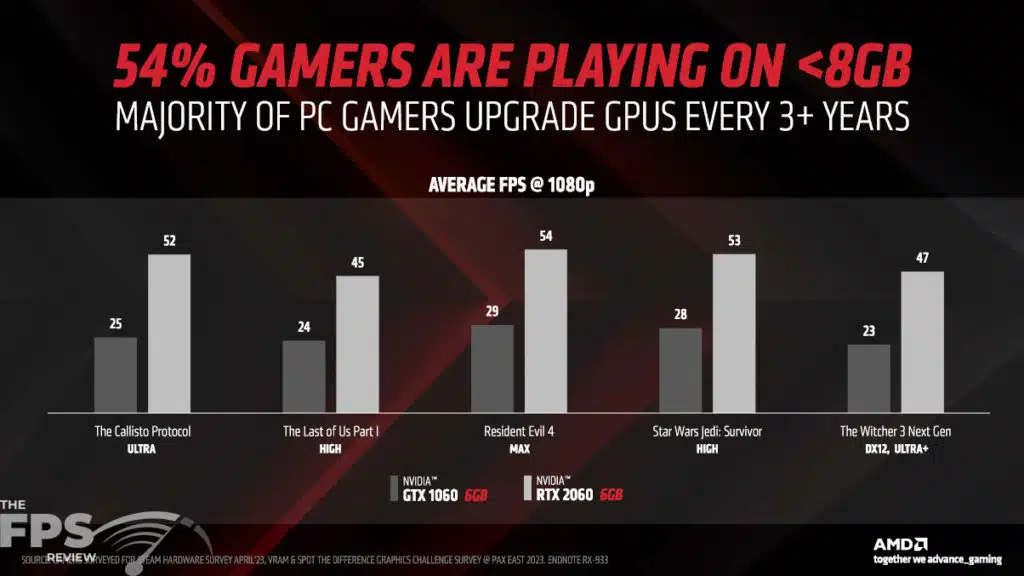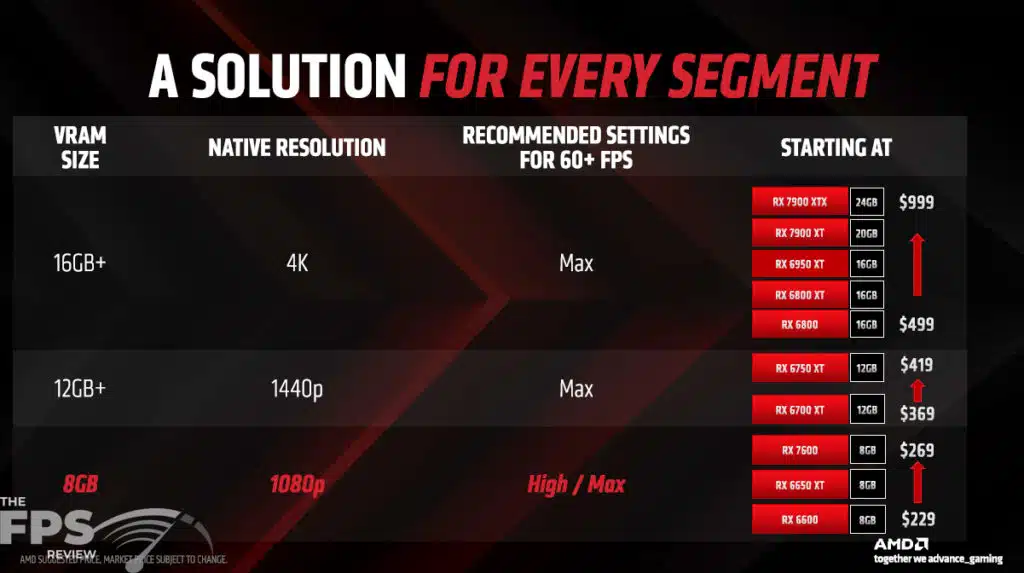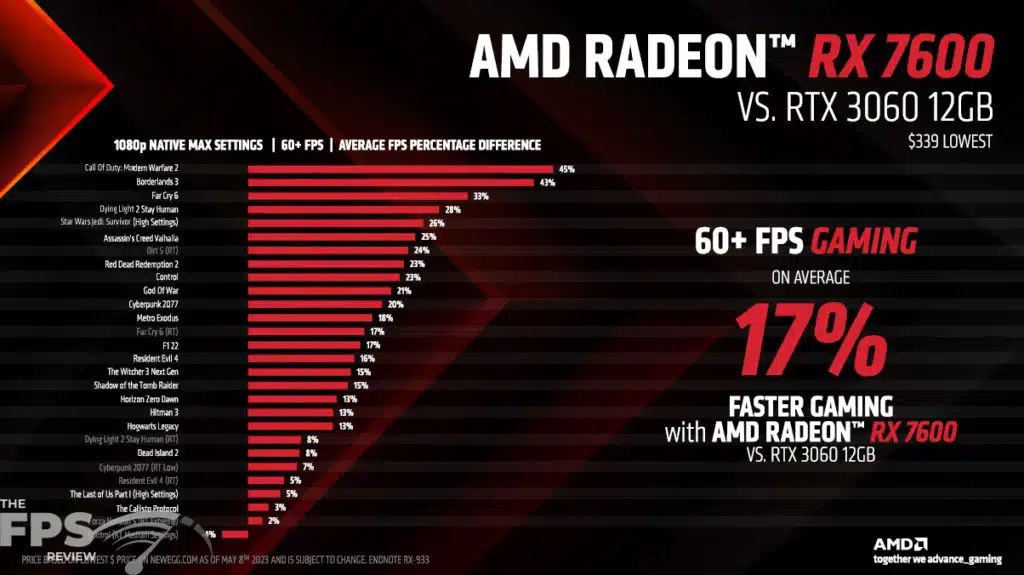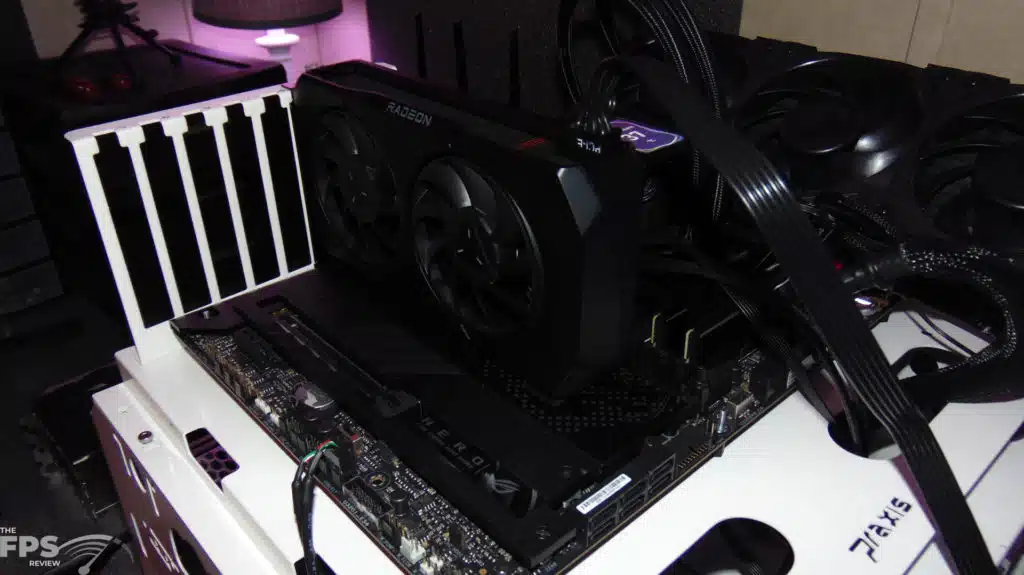
Introduction
It has been five and a half months since AMD launched its brand new Radeon RX 7000 series GPUs based on the new RDNA 3 architecture. In December of 2022, AMD released both the enthusiast high-end Radeon RX 7900 XTX and Radeon RX 7900 XT. The Radeon RX 7900 XTX has an MSRP of $999 and the Radeon RX 7900 XT has an MSRP of $899. It has taken AMD almost six whole months to finally give us another addition to the Radeon RX 7000 series family, and it is just one GPU launching today. This time, AMD is giving us the entire opposite end of the spectrum, and going mainstream by adding the new Radeon RX 7600 to the RDNA 3 lineup.
The AMD Radeon RX 7600 is aimed at the 1080p gameplay experience, mainstream market segment, and will have an exciting MSRP of just $269. It seems AMD is hitting the spectrum at both ends, by first releasing its top-end product, and now its lowest-end product. That does, however, leave a lot of room in the middle that we hope AMD fills in quickly this summer. Let’s talk about the new Radeon RX 7600.
As we mentioned, the AMD Radeon RX 7600 will have a suggested retail price set at $269. AMD will offer a made-by-AMD model, and that is the model we are reviewing today. There will also be AIB custom card designs available on May 25th, 2023. You can probably expect models with factory overclocks, and price premiums. Thankfully AMD is pricing the Radeon RX 7600 well under $300, and this means it provides some interesting price to performance metrics.
If you look at AMD’s last generation video card in this segment, the AMD Radeon RX 6600, it launched at the end of 2021 at an MSRP of $329. It was refreshed in the Spring 2022 refresh by the Radeon RX 6650 XT at a $399 MSRP. Therefore, the new Radeon RX 7600 as an upgrade from the Radeon RX 6600 is happening at a suggested retail price that is 18% ($60) below the previous generation! A potentially faster video card is being offered, at a reduced MSRP versus the previous generation! It’s almost unheard of these days but extremely welcomed. Therefore we will have to put the Radeon RX 7600 to the test at 1080p, with Ray Tracing and FSR to see how it stacks up.
AMD Radeon RX 7600 Specifications




Let’s start with the basics, the new Radeon RX 7600 is based on the newest RDNA 3 architecture, the same as the Radeon RX 7900 XTX and 7900 XT. You can read about that architecture here where we have laid out all the specifics. The Radeon RX 7600 at $269 is aimed squarely at the 1080p gaming space. For this price point, that makes sense. As AMD shows, the Radeon RX 7600 occupies the mainstream segment, while the previous generation RDNA 2 GPUs occupy the middle segments until you get to ultra-enthusiast with the RX 7900 XTX and 7900 XT. Hopefully, AMD will fill in the enthusiast and premium segments with RDNA 3 GPUs soon, we cannot rely on the previous generation forever.








The newly released NVIDIA GeForce RTX 4060 Ti is not the price competitor, or performance competitor, to the new AMD Radeon RX 7600. The two video cards operate at two separate price and performance segments. Therefore while these two video cards are being released at the same time here in May 2023, they are not directly price or performance comparable. We just wanted to mention that, because the comparison cards appropriate for the Radeon RX 7600 are different than the cards that compare to the GeForce RTX 4060 Ti.


AMD Radeon RX 7600 is manufactured on TSMC 6nm and is the NAVI 33XL GPU. It has 32 Compute Units, 32 Ray Accelerators, 64 AI Accelerators, 64 ROPs, and 2,048 Stream Processors. It has 32MB of 2nd Gen AMD Infinity Cache. The Game GPU Clock is 2250MHz and the Boost GPU Clock can go up to 2625MHz. It has 8GB of GDDR6 VRAM capacity at 18GHz on a 128-bit memory bus providing 288GB/s of actual memory bandwidth. It uses a PCIe 4.0 x8 lanes interface. The Total Board Power is 165W. AMD recommends a 550W power supply.
For some comparison, the Radeon RX 6600 also had 8GB of GDDR6 on a 128-bit memory bus, but it ran at 14GHz with 224GB/s of actual memory bandwidth. Therefore, on the memory subsystem, the new Radeon RX 7600 gets an upgrade in memory frequency to 18GHz, meaning higher memory bandwidth at 288GB/s. The Radeon RX 6600 also had 32MB of Infinity Cache, but it was 1st Gen, not 2nd Gen.



The Radeon RX 6600 had fewer Stream Processors with 1,792 versus 2,048 on the RX 7600. The Radeon RX 6600 had a lower Game GPU Clock of 2044MHz and Boost GPU Clock of 2491MHz. Therefore the Radeon RX 7600 provides an upgrade in a better manufacturing node of 6nm versus 7nm on RX 6600, a higher transistor count of 13.3 billion versus 11.1 billion on RX 6600, and yet a smaller Die Size of 204mm2 versus 237mm2 on RX 6600. The Radeon RX 7600 has a new architecture based on RDNA 3, more Stream Processors, higher GPU clocks, new AI Accelerators, and faster VRAM with higher bandwidth. The Total Board Power did increase from 132W on the Radeon RX 6600 to now 165W on the Radeon RX 7600. Both have a PCIe Gen 4 x8 PCIe Interface.
AMD Radeon RX 7600 Pictures


The built by AMD Radeon RX 7600 comes in a very compact form fact, utilizing the new shroud design implemented on the higher-end RX 7900 XTX and 7900 XT. The shroud encompasses the entire video card, wrapping around the end. There is a grill vent on the top, which can let heat escape naturally. The entire video card feels solid and well-built.




One of the greatest features of this video card is its size. The Radeon RX 7600 measures only 8.5 inches long and 1.5 inches in width, so it fits in perfectly in a 2-slot design and should fit really well in small form factor cases and small builds.








Because the AMD Radeon RX 7600 uses AMD’s new Radiance Display Engine it comes equipped with DisplayPort 2.1 support with link bandwidth up to 54Gbps. Due to the inclusion of AMD’s latest Media Engine, the video card also supports AV1 encoding. It has 3x DisplayPorts and 1x HDMI 2.1a. The AMD Radeon RX 7600 requires one single 8-pin PCIe power connector and AMD recommends a 550W power supply.
